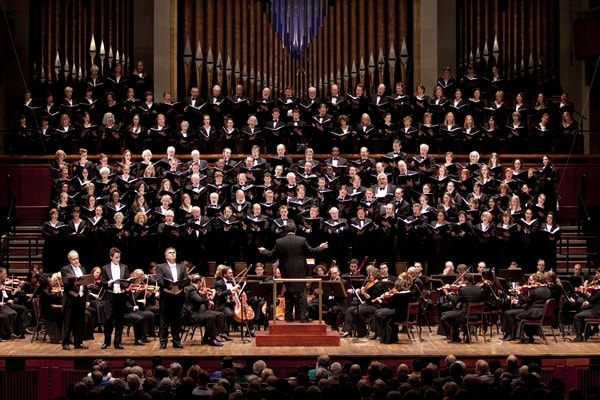On Sunday, November 13, 2016, the pulsating, transcendent and visionary music of the modern musical giant of minimalist music, Philip Glass —came to vivid life in a unique and powerful concert event. The Washington Chorus presented a stirring interpretation of Mr. Glass’ Symphony No. 5.

This transformative symphonic piece is challenging like all of Glass’ music but the Washington Chorus under the spirited baton of Conductor and Music Director Julian Wachner was “ahead of the artistic curve” on every layer of presentation, technique, and sheer artistic excellence embodied in this invigorating symphonic concert.
The presentation itself was a marvel to behold as I peered at the Kennedy Center Concert Hall stage. On the upper tier were row after row of the wonderful members of the Washington Chorus and on the second tier of rows (drawing nearer the front of the stage) were the Washington National Cathedral Choir Girl Choristers (Michael McCarthy, Director).
Arranged on the actual stage floor itself were the splendid and sensitive members of the Washington Chorus Orchestra and assembled prominently in front of the Orchestra were five outstanding, renowned vocal soloists: Soprano Heather Buck, Mezzo-Soprano Katherine Pracht, Tenor John McVeigh, Baritone Stephen Salters, and Bass-Baritone David Cushing. It was a veritable embarrassment of riches!
If this heady brew of musical and symphonic accompaniment were not enough, add in the highly poetic and “image –laden” libretto of this symphony which consists of diverse passages and lines from a treasure trove of sacred texts, stories and traditions ranging from the Bible to the Qur’an to the Bhagavad Gita.
Encompassing the wide–range of the human condition and the transcendent soul, Glass’s Symphony No. 5 is a rich tapestry that is a bridge between the past, present and the future as embodied in the three main sections of this magnificent symphonic piece. The first section is the “Requiem,” the second section is the “Bardo” (representing the “in-between”), and the third section is the “Nirmanakaya” (rebirth as manifestation of enlightened activity).
These three sections are broken down into twelve distinct but naturally connected movements that stress the commonalities found in all the religions and in the human condition. Universal themes of creation, compassion, suffering, evil, compassion, death, apocalypses and paradise are all “grist for the mill” of the human experience.

The most important layer of richness in this potent and very spiritual concert is the music of the Symphonic piece itself ––and has there ever been any other composer quite like Philip Glass? The usual Glass trademarks are all here from the swirling motifs, tranquil repetitive patterns, the mystical/transcendent feeling and the pulsating sounds that suddenly erupt into a euphoric sort of fiery dissonance. The Washington Chorus, the Choir Girl Choristers, and the Washington Chorus Orchestra itself lend their expert musical embellishments to perfectly underscore the reflective yet enthralling musical patterns of Mr. Glass’s beautiful Symphony no. 5.
The Choruses at full–throttle were at their most effective when interpreting the more dramatic sections of the sacred writings. Particularly outstanding was the “Fire Sermon” from the Maha-Vagga.
Yet–if I was forced to single out any of the musical accompaniment to this metaphysical Symphony, I might have to look toward the stunning interpretive vocal prowess of the five lead soloists.
The movement entitled “Creation of Human Beings” (from the Popul Vuh) shone due to the expressive singing of Ms. Heather Buck.
Tenor John McVeigh invested his considerable skills into a beautiful passage from the Qur’an (15:26-37).
David Cushing’s resonant Bass-Baritone infused the movement on “Suffering” from the Book of Job.
Baritone Stephen Salters’ rich and robust voice permeated all he sang with a deep and plaintive resonance.
Mezzo-Soprano Katherine Pracht excelled at a slightly intense and probing vocal delivery.
The music of Philip Glass has never been easy to categorize in a facile manner and this performance of his Symphony No. 5 is no exception. I cried copious tears many times during this performance —-so awestruck was I by the sheer beauty and truth of this Symphony. However, the tears did not come easily; they were weighted down with too much of the commensurate gravitas Glass interjects in all his works.
I could only think of poet William Wordsworth’s words as Glass defied easy sentiment in favor of often harsh but universal truths:
To me the meanest flower that blows can give thoughts that lie too deep for tears.
Running Time: One hour and 45 minutes, with no intermission.
Philip Glass’s Symphony No. 5 was performed by the Washington Chorus on Sunday, November 13, 2016, at The Kennedy Center’s Concert Hall – 2700 F Street, NW, in Washington, DC. For further information on Washington Chorus events go to their website.
RATING:





